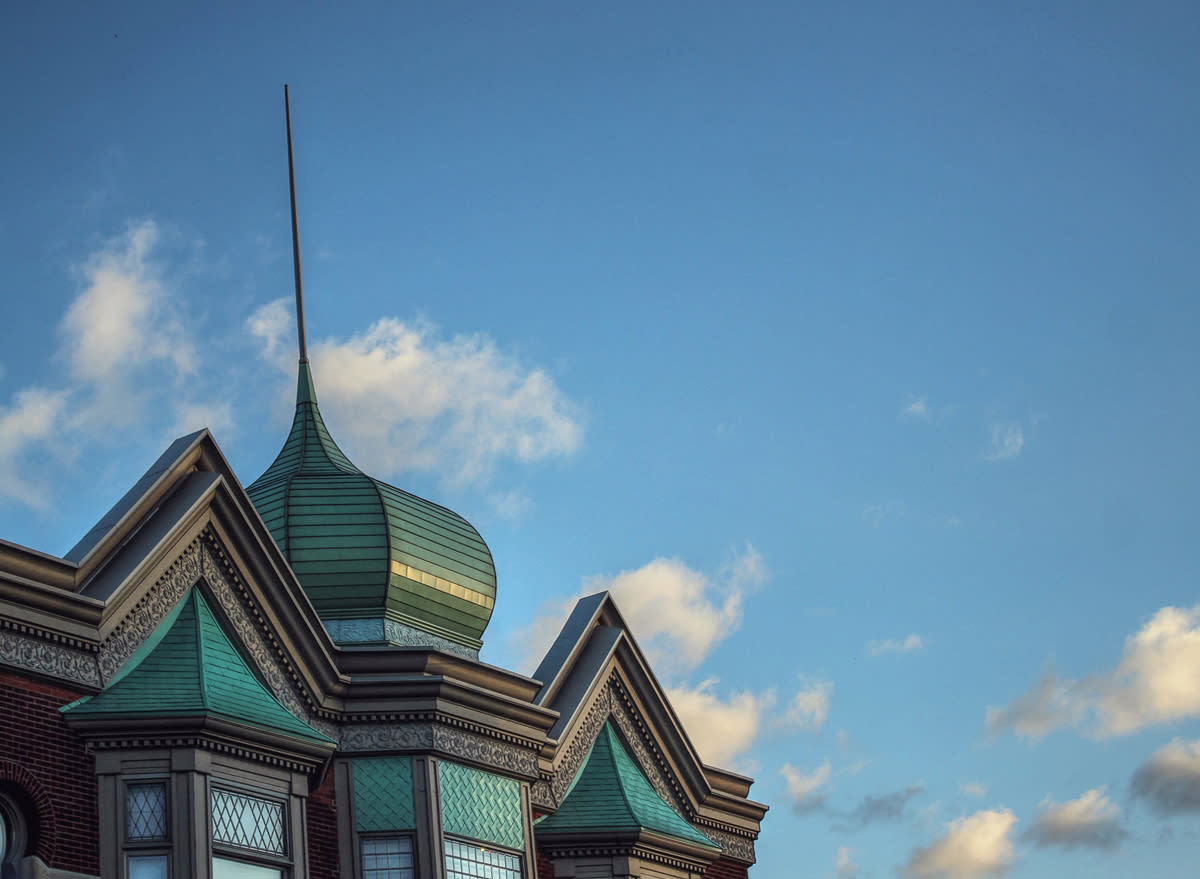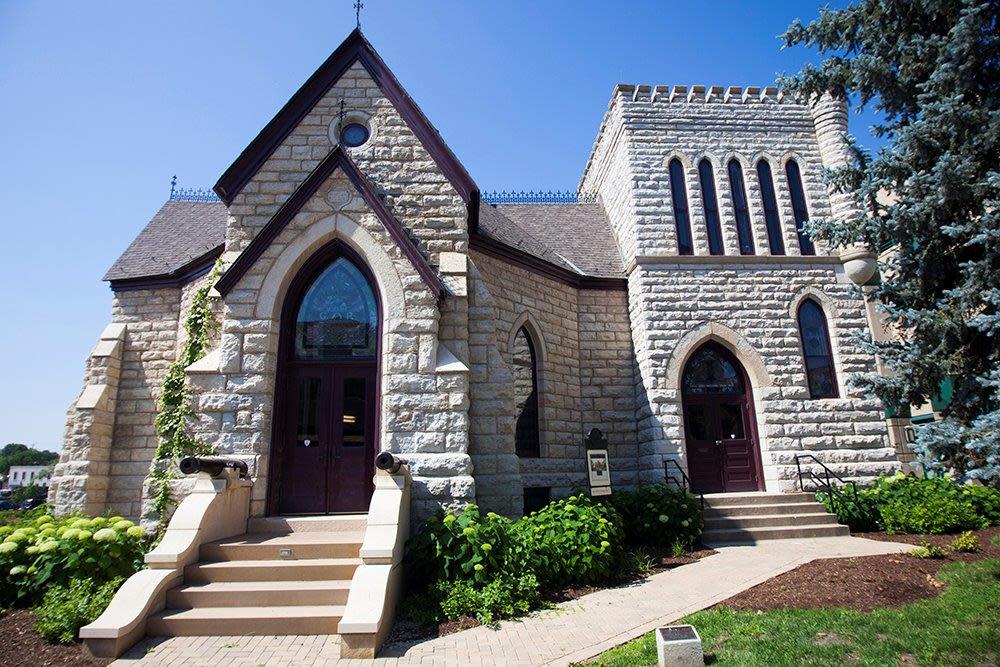
Aurora Regional Fire Museum / Photo credit: Randy Benzie.
Just an hour west of Chicago, the Aurora Area of Illinois is rich with historical structures and an eclectic mix of charming towns set along the scenic Fox River. Victorian and Italianate architecture leads the way here, with several homes, barns, and other structures certified by the National Register of Historic Places. Our guide to some of the most unique places in the Aurora Area takes you from an historic Art Deco theatre to a one-of-a-kind railroad roundhouse, a publicly accessible national laboratory, and stops along the way at an iconic glass house designed by Mies Van der Rohe. Here’s a two-day guide to checking out some the best architecture in the Aurora Area, Illinois.
Day 1: Architecture In Aurora

The first day of the architecture tour should begin in the City of Aurora at Tanner House on Cedar Street, a historic building built in 1857. Owned by a local hardware merchant, William Tanner, his wife and their 10 children were among the first residents to live in the area. Walking up to the Italianate-style house-turned-museum, guests can admire the octagon cupola nesting on its roof and its high-arched ceilings. Inside, visitors will browse through the collection of original furniture, oak-grained woodwork, ornate plaster decorations, and vintage photographs of its former residents. Next stop, cross over to the other side of Fox River to Two Brothers Roundhouse on North Broadway. The roundhouse is considered the oldest of its kind in the United States and was built in 1856 by the Chicago, Burlington & Quincy Railroad. At over 70,000 square feet, the roundhouse is known for its dazzling limestone structure and was later renovated by famous NFL Chicago Bear Walter Payton in 1996. Today, the roundhouse operates as a restaurant and a microbrewery for guests to enjoy steaks and burgers with local beer while admiring the rich architecture. The interior courtyard with massive stone fireplace invites guests to savor the change of seasons.

Photo credit: Wikimedia Commons.
After a satisfying lunch, make your way to RiverEdge Park, directly across the street from Two Brothers Roundhouse. The 30-acre park is used for multiple purposes; home to big-name concerts and festivals it features sweeping views of the Fox River and downtown Aurora. Nature and outdoor enthusiasts can opt to bring their own bikes, kayaks or canoes to explore the Fox River and its adjoining trails throughout the Aurora Area. Take a walk along the river to check out the iconic New York Street Memorial Bridge that spans over the entire river. Keep your eyes peeled for the “Memory” and “Victory” statues that were built in 1930 and commemorated in honor of fallen soldiers. The bridge was built in the same year by Emory P. Seidel, who envisioned that bridges should not look so drab but rather as magnificent structures of gorgeous architecture.

As you keep walking south along the Fox River, cross over Galena Boulevard to visit Paramount Theatre that's located on a small strip of land in the middle of the Fox River. Much of downtown Aurora is located on Stolp Island, which cuts the Fox River into two channels. At the Paramount Theatre, visitors will notice a Venetian theme mixed with Art Deco touches throughout the theater. The theater is known for its brilliant design of acoustics and sight lines, ensuring that any seat in the house is great. The theater has been cited as one of the top 10 in Chicago by the League of Chicago Theatres and produces a Broadway-caliber musical series as well as national and regional traveling shows and top-name entertainers. Check with the theatre’s website to plan ahead for the desired show. Tickets can be purchased online.

Just south of the Paramount Theatre, on the retail thoroughfare Downer Place, sits a relic of the Aurora Area's Civil War history. The Grand Army of the Republic Memorial Museum is a newly renovated Civil War veterans hall that once hosted over 700 veteran members from 70 different regiments as the Grand Army of the Republic Local Post 20 meeting place. The Grand Army of the Republic Hall is listed on the National Register of Historic Places and has been honored with the 2016 President's Award for Preservation by Landmarks Illinois. Precision and an exacting attention to detail went into the restoration of the building over the past 20 years, including faithful re-creations of the inlaid stained glass and woodwork in the main hall. The Grand Army of the Republic Memorial Museum is now open to the public for self-guided tours with over a dozen educational exhibits on local and Illinois' history of the Civil War, the role of women and immigrants in the winning of the war, and on the formation and organization of the Grand Army of the Republic veterans halls across the country, making this a perfect addition to architecture tours, school field trips, and getaways along the historic Lincoln Highway.
Day 2: Architecture of the Aurora Area

Start your second day of gorgeous architecture sightings at the Historic Kendall County Courthouse in Yorkville. The 1864 Victorian Italianate building is home to several exhibits of local artwork that highlights the natural resources of the area. Currently listed among National Register of Historic Places, the courthouse has breathtaking arched windows and vintage furnishings.
Afterwards, head over to Farnsworth House in Plano (about an 11-minute drive from Yorkville). The house was built in 1951 by the world-renowned architect Ludwig Mies van der Rohe. The house is considered a world-famous masterpiece representing modernist domestic architecture and minimalist design. The house, which looks like a “glass box,” is known for its aesthetic approach to nothingness, yet it was revolutionary in the architecture community. Today, visitors can join a tour of the house and grounds and learn more about this stunning work by van der Rohe and how it came to be along the banks of the Fox River in Plano, IL.

A five-minute drive from Farnsworth House is the Homestead Bed & Breakfast (still in Plano). Whether you’re spending the night there or visiting, the inn is worth checking out due to the immaculate condition of architecture designed to resemble villas in Tuscany. Built in 1854, the place is listed among the National Register of Historic Places and is known for its beautiful maze-like landscape. Visitors staying overnight will have the option to choose from five rooms and suites with their own personalities and charm, and will be served a gourmet breakfast in the morning. The inn and its grounds is also a popular location for weddings, receptions, business retreats and creative meeting spaces.

A short drive east is the eclectic Village of Oswego, a destination for shopping, dining, and unique attractions that invite you to spend time exploring this forward-thinking community. Grab a bite to eat or a cup of hand-crafted coffee at The Village Grind, a cozy café favored by locals in downtown Oswego. Walk down to Hudson Crossing Park and see where the village was founded at a site that once served early inhabitants and settlers of the region as a smooth route across the Fox River. More local history can be found at the Little White School Museum. Constructed between 1848 and 1850, the building has been used as a church, a school, and now serves locals and visitors alike as a museum, housing the village’s historical archives, exhibits, and demonstrations by visiting artists and organizations. Its classic, mid-19th century Greek Revival design and construction has been deemed architecturally significant by local architects, and the building’s become a fixture of the community, having been located in its current site for approximately 160 years.
The Stone Houses of Oswego are a collection of notable buildings located throughout the village. You can access an online brochure of these sites and conduct your own self-guided tour, observing a range of architectural styles ranging from Kendall County’s only surviving Second Empire building, the George D. Wormley House, to native limestone structures and excellent examples of Greek Revival homes.

Next stop is Wilson Hall at the Fermi National Accelerator Laboratory (Fermilab) in Batavia. Fermilab is known for its research and experimentation on particle acceleration and molecular physics since 1967. With over 6,800 acres, the Fermilab grounds include nature trails, bike paths, fishing ponds and a herd of prairie bison. Also on campus is Wilson Hall, where guests can browse through exhibits of art works, science discovery and more. Completed in 1974, Wilson Hall is a modernist masterpiece on the prairie in Batavia. The soaring 17-story atrium of Wilson Hall is an architectural wonder and must see for architecture fans.


